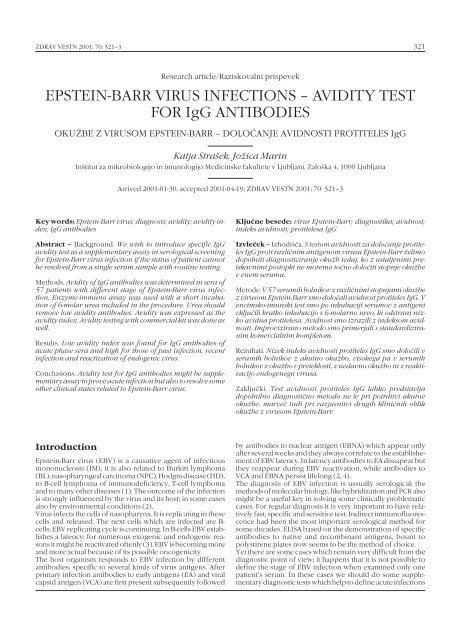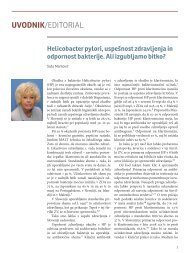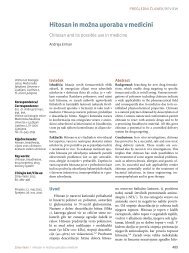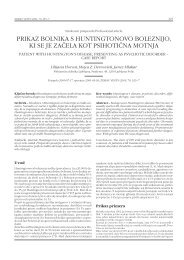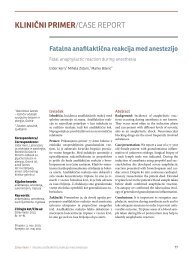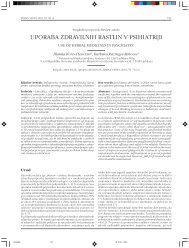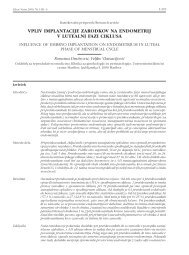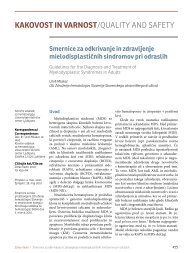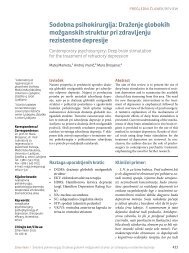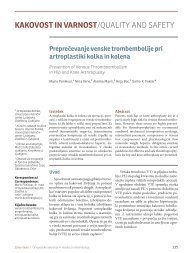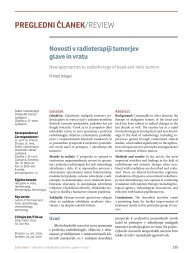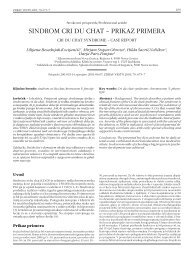AVIDITY TEST FOR IgG ANTIBODIES
AVIDITY TEST FOR IgG ANTIBODIES
AVIDITY TEST FOR IgG ANTIBODIES
You also want an ePaper? Increase the reach of your titles
YUMPU automatically turns print PDFs into web optimized ePapers that Google loves.
ZDRAV VESTN 2001; 70: 321–3<br />
321<br />
Research article/Raziskovalni prispevek<br />
EPSTEIN-BARR VIRUS INFECTIONS – <strong>AVIDITY</strong> <strong>TEST</strong><br />
<strong>FOR</strong> <strong>IgG</strong> <strong>ANTIBODIES</strong><br />
OKUŽBE Z VIRUSOM EPSTEIN-BARR – DOLOČANJE AVIDNOSTI PROTITELES <strong>IgG</strong><br />
Katja Strašek, Jožica Marin<br />
Inštitut za mikrobiologijo in imunologijo Medicinske fakultete v Ljubljani, Zaloška 4, 1000 Ljubljana<br />
Arrived 2001-01-30, accepted 2001-04-19; ZDRAV VESTN 2001; 70: 321–3<br />
Key words: Epstein-Barr virus; diagnosis; avidity; avidity index;<br />
<strong>IgG</strong> antibodies<br />
Abstract – Background. We wish to introduce specific <strong>IgG</strong><br />
avidity test as a supplementary assay in serological screening<br />
for Epstein-Barr virus infection if the status of patient cannot<br />
be resolved from a single serum sample with routine testing.<br />
Methods. Avidity of <strong>IgG</strong> antibodies was determined in sera of<br />
57 patients with different stage of Epstein-Barr virus infection.<br />
Enzyme-immuno assay was used with a short incubation<br />
of 6-molar urea included in the procedure. Urea should<br />
remove low avidity antibodies. Avidity was expressed as the<br />
avidity index. Avidity testing with commercial kit was done as<br />
well.<br />
Results. Low avidity index was found for <strong>IgG</strong> antibodies of<br />
acute phase sera and high for those of past infection, recent<br />
infection and reactivation of endogenic virus.<br />
Conclusions. Avidity test for <strong>IgG</strong> antibodies might be supplementary<br />
assay to prove acute infection but also to resolve some<br />
other clinical states related to Epstein-Barr virus.<br />
Ključne besede: virus Epstein-Barr; diagnostika; avidnost;<br />
indeks avidnosti; protitelesa <strong>IgG</strong><br />
Izvleček – Izhodišča. S testom avidnosti za določanje protiteles<br />
<strong>IgG</strong> proti različnim antigenom virusa Epstein-Barr želimo<br />
dopolniti diagnosticiranje okužb tedaj, ko z ustaljenimi preiskavnimi<br />
postopki ne moremo točno določiti stopnje okužbe<br />
v enem serumu.<br />
Metode. V 57 serumih bolnikov z različnimi stopnjami okužbe<br />
z virusom Epstein-Barr smo določali avidnost protiteles <strong>IgG</strong>. V<br />
encimsko-imunski test smo po inkubaciji serumov z antigeni<br />
vključili kratko inkubacijo s 6-molarno ureo, ki odstrani nizko<br />
avidna protitelesa. Avidnost smo izrazili z indeksom avidnosti.<br />
Improvizirano metodo smo primerjali s standardiziranim<br />
komercialnim kompletom.<br />
Rezultati. Nizek indeks avidnosti protiteles <strong>IgG</strong> smo določili v<br />
serumih bolnikov z akutno okužbo, visokega pa v serumih<br />
bolnikov z okužbo v preteklosti, z nedavno okužbo in z reaktivacijo<br />
endogenega virusa.<br />
Zaključki. Test avidnosti protiteles <strong>IgG</strong> lahko predstavlja<br />
dopolnilno diagnostično metodo ne le pri potrditvi akutne<br />
okužbe, marveč tudi pri razjasnitvi drugih kliničnih oblik<br />
okužbe z virusom Epstein-Barr.<br />
Introduction<br />
Epstein-Barr virus (EBV) is a causative agent of infectious<br />
mononucleosis (IM); it is also related to Burkitt lymphoma<br />
(BL), nasopharyngeal carcinoma (NPC), Hodgin disease (HD),<br />
to B-cell lymphoma of immunodeficiency, T-cell lymphoma<br />
and to many other diseases (1). The outcome of the infection<br />
is strongly influenced by the virus and its host; in some cases<br />
also by environmental conditions (2).<br />
Virus infects the cells of nasopharynx. It is replicating in these<br />
cells and released. The next cells which are infected are B-<br />
cells; EBV replicating cycle is continuing. In B-cells EBV establishes<br />
a latency; for numerous exogenic and endogenic reasons<br />
it might be reactivated oftenly (3). EBV is becoming more<br />
and more actual because of its possible oncogenicity.<br />
The host organism responds to EBV infection by different<br />
antibodies, specific to several kinds of virus antigens. After<br />
primary infection antibodies to early antigens (EA) and viral<br />
capsid antigen (VCA) are first present subsequently followed<br />
by antibodies to nuclear antigen (EBNA) which appear only<br />
after several weeks and they always correlate to the establishement<br />
of EBV latency. In latency antibodies to EA dissapear but<br />
they reappear during EBV reactivation, while antibodies to<br />
VCA and EBNA persist lifelong (2, 4).<br />
The diagnosis of EBV infection is ussually serological; the<br />
methods of molecular biology, like hybridization and PCR also<br />
might be a useful key in solving some clinically problematic<br />
cases. For regular diagnosis it is very important to have relatively<br />
fast, specific and sensitive test. Indirect immunofluorescence<br />
had been the most important serological method for<br />
some decades. ELISA based on the demonstration of specific<br />
antibodies to native and recombinant antigens, bount to<br />
polystirene plates now seems to be the method of choice.<br />
Yet there are some cases which remain very difficult from the<br />
diagnostic point of view; it happens that it is not possible to<br />
define the stage of EBV infection when examined only one<br />
patient’s serum. In these cases we should do some supplementary<br />
diagnostic tests which help to define acute infections
322 ZDRAV VESTN 2001; 70<br />
or other stages of infection. One of these tests could be the<br />
avidity test of specific <strong>IgG</strong> antibodies or Western blot.<br />
Avidity tells about the strength of antibodies’ binding to multivalent<br />
antigen. Avidity can be measured after short incubation<br />
of the antigen-antibody complex with 6 M urea (5). High<br />
avidity antibodies persist in binding to the antigen, while low<br />
avidity antibodies are destroyed after the addition of urea.<br />
In this study we’ve measured the avidity of <strong>IgG</strong> antibodies<br />
(anti-EA, anti-VCA, anti-EBNA) in sera of patients previously<br />
examined by ELISA to define their immune status to EBV.<br />
The results of »in house« avidity test were compared to the<br />
results obtained by commercially available test kit, oriented to<br />
measure avidity of <strong>IgG</strong> anti-EBV.<br />
Material and methods<br />
Sera of patients. In this study 74 sera of patients previously<br />
examined for EBV immune status (4, 7) were included for<br />
measuring <strong>IgG</strong> antibodies’ avidity. According to their anti-EBV<br />
status sera were divided into four groups: patients’ sera with<br />
acute EBV infection (n = 22), recent infection (n = 18), past<br />
infection (n = 11) and with virus reactivation (n = 23).<br />
»In house« avidity test. All sera were repetedly tested by ELISA.<br />
After the incubation of sera with specific antigens, the plates<br />
were washed; in each well 100 µl of 6 M urea was added for 3<br />
mins at room temperature. Urea was removed, the plates were<br />
washed again and ELISA was continued as described elsewhere<br />
(5, 7).<br />
Avidity test with commercial kit – Enzygnost Anti-EBV <strong>IgG</strong>;<br />
Avidity Reagent for Enzygnost (Dade Behring, Marburg, Germany).<br />
This test was performed following instructions of the<br />
manufacturer (8).<br />
Measurement of avidity. Avidity of <strong>IgG</strong> antibodies is expressed<br />
by the avidity index (AI). In »in house« avidity test AI was obtained<br />
when optical density (OD) of the sample, treated with<br />
urea, was devided by OD of the same sample which was not<br />
treated with urea. When AI is 0.50–1.00, it means high avidity<br />
of <strong>IgG</strong> antibodies and this is characteristic for past infection.<br />
When AI is < 0.25, it means low avidity of <strong>IgG</strong> antibodies and<br />
this reflects acute infection. AI values of 0.25–0.50 are equivocal<br />
(5).<br />
By the use of commercial test kit, AI was determined in the<br />
same way as in »in house« avidity test; the only difference was<br />
that the quocient was multiplied by 100. So AI was expressed<br />
in percentages. Cut off value was 40% (8).<br />
Statistics. The results were statistically evaluated in different<br />
EBV infections by χ 2 test.<br />
Results<br />
»In house« avidity test<br />
Avidity of <strong>IgG</strong> anti-EA. <strong>IgG</strong> anti-EA were present in 31 sera<br />
tested: 18 sera belonged to patients with acute infection, 13 to<br />
patients with recent infection. In 6 sera of patients with acute<br />
infection OD fell under the cut off value after the treatment<br />
with urea. In 2 sera of patients with recent infection antibodies<br />
were destroyed after the treatment with urea. Average<br />
values of AI in acute and recent infection are presented in<br />
Figure 1. The differences are statistically significant (p = 0.05).<br />
Avidity of <strong>IgG</strong> anti-EBNA. <strong>IgG</strong> anti-EBNA were determined in<br />
sera of 25 patients: in 17 of them with virus reactivation, in 8<br />
with recent infection. After the treatment with urea in 8 sera<br />
of patients with reactivated virus a minor fall of OD was<br />
found. The same results were observed in the group of patients<br />
with recent infection. Average AI values in both groups<br />
were high (Fig. 2). The differences were not statistically significant.<br />
Avidity index (average values)<br />
Povpreèni indeks avidnosti<br />
1,2<br />
1,0<br />
0,8<br />
0,6<br />
0,4<br />
0,2<br />
0,0<br />
Acute / Akutna<br />
Recent / Nedavna<br />
Stage of infection / Stopnja okužbe<br />
Fig. 1. Graphical presentation of avidity index for <strong>IgG</strong> anti-EA.<br />
Sl. 1. Grafični prikaz indeksa avidnosti <strong>IgG</strong> anti-EA.<br />
Avidity index (average values)<br />
Povpreèni indeks avidnosti<br />
1,2<br />
1,0<br />
0,8<br />
0,6<br />
0,4<br />
0,2<br />
0,0<br />
Recent / Nedavna<br />
Virus reactivation /<br />
Reaktivacija virusa<br />
Stage of infection / Stopnja okužbe<br />
Fig. 2. Graphical presentation of avidity index for <strong>IgG</strong> anti-<br />
EBNA.<br />
Sl. 2. Grafični prikaz indeksa avidnosti <strong>IgG</strong> anti-EBNA.<br />
Avidity of <strong>IgG</strong> anti-VCA. <strong>IgG</strong> anti-VCA were determined in sera<br />
of 18 patients; 4 of them with acute infection, 4 with the past<br />
infection, 5 with recent infection and 5 of them experienced<br />
the virus reactivation. In all sera the fall of OD values were<br />
found after the treatment with urea. Average AI values were<br />
borderline or higher (Fig. 3). The differences were statistically<br />
significant only between patients with acute and recent infection<br />
(p = 0.05).<br />
Commercial test kit<br />
Avidity of <strong>IgG</strong> anti-EBV. <strong>IgG</strong> anti-EBV were found in sera of 17<br />
patients: 7 of them had past infection, 4 patients had reactivated<br />
virus, in 3 patients acute infection was determinated and<br />
in 3 patients recent infection. In sera of patients with acute<br />
infection the evident fall of OD values were found after the<br />
treatment with »avidity reagent«. Average AI values were low<br />
in this group as well. In other groups of sera AI was high (Fig.<br />
4). Statistically significant differences were found between sera<br />
of patients with acute and past infection and also between<br />
acute infection and reactivated virus (p = 0.05). The differences<br />
in AI between sera with acute and recent infection were<br />
not significant.
STRAŠEK K, MARIN J. EPSTEIN-BARR VIRUS INFECTIONS – <strong>AVIDITY</strong> <strong>TEST</strong> <strong>FOR</strong> <strong>IgG</strong> <strong>ANTIBODIES</strong><br />
323<br />
Avidity index (average values)<br />
Povpreèni indeks avidnosti<br />
0,6<br />
0,5<br />
0,4<br />
0,3<br />
0,2<br />
0,1<br />
0,0<br />
80<br />
70<br />
60<br />
50<br />
40<br />
30<br />
20<br />
10<br />
0<br />
Specificity and sensitivity of the avidity test<br />
The specificity of our test was 59.38% and the sensitivity 91.67%.<br />
Discussion<br />
Acute<br />
Akutna<br />
Recent<br />
Nedavna<br />
Virus reactivation<br />
Reaktivacija virusa<br />
Stage of infection / Stopnja okužbe<br />
Past<br />
Pretekla<br />
Fig. 3. Graphical presentation of avidity index of <strong>IgG</strong> anti-<br />
VCA.<br />
Sl. 3. Grafični prikaz indeksa avidnosti <strong>IgG</strong> anti-VCA.<br />
Avidity index (average values)<br />
Povpreèni indeks avidnosti<br />
Acute<br />
Akutna<br />
Recent<br />
Nedavna<br />
Past<br />
Pretekla<br />
Stage of infection / Stopnja okužbe<br />
Virus reactivation<br />
Reaktivacija virusa<br />
Fig. 4. Graphical presentation of avidity index of <strong>IgG</strong> anti-<br />
EBV.<br />
Sl. 4. Grafični prikaz indeksa avidnosti <strong>IgG</strong> anti-EBV.<br />
The measurement of <strong>IgG</strong> anti-EBV avidity might be a supplementary<br />
diagnostic procedure in the situation of problematic<br />
clinical cases, when we are not able to define precisely the<br />
stage of EBV infection (8, 9). Normally, we do diagnosis of<br />
EBV infection by ELISA; sometimes the result is not in good<br />
correlation to the clinical state of the patient – in most cases<br />
these are adult patients with laboratory determined recent<br />
infection. This is, according to the known EBV epidemiological<br />
situation in our population, quite unusual. We suppose<br />
that these patients in fact do not experience recent infection,<br />
but they might have just gone through EBV reactivation: IgM<br />
anti-EA have dissapeared, the patients still have <strong>IgG</strong> anti-EA<br />
and of course they have permanently present <strong>IgG</strong> anti-EBNA.<br />
This patients were a perfect challange for us to introduce »in<br />
house« avidity test, which has found that both patients with<br />
»recent« infection and patients with EBV reactivation had <strong>IgG</strong><br />
antibodies with high avidity; but as a rule, in recent infection<br />
<strong>IgG</strong> antibodies should have low avidity. In this study only adult<br />
patients were included and so it remains to compare <strong>IgG</strong> avidity<br />
of children with laboratory diagnosed recent infection.<br />
Preliminary we presume that the avidity of <strong>IgG</strong> (anti-EA, anti-<br />
VCA and eventually anti-EBNA) should be low.<br />
Avidity test we have used in the study was not standardized.<br />
This is also the reason why the differences in optical density<br />
of »normal« sera and of sera treated with urea were not as clear<br />
as we had expected. The same problem was mentioned by<br />
Weissbrich (6). This author advises to use immunofluorescence<br />
when avidity is to be measured. So we here tested a<br />
minor number of sera with anticomplement immunofluorescence.<br />
To measure avidity, the treatment with urea was included<br />
in the test as well. The results incouraged us and we<br />
agree with Weissbrich, that the results of avidity in immunofluorescence<br />
are more easy to interpret than with ELISA.<br />
At the end of the study the commercial avidity test was offered<br />
to us and we were able to test some sera. We believe that this<br />
test kit will be really very helpful in EBV diagnosis. By the use<br />
of this kit the avidity of all <strong>IgG</strong> antibodies are determined; the<br />
results our study point to the avidity of specific <strong>IgG</strong> and this is<br />
our scientific contribution to general knowledge of avidity.<br />
The main privilege of the commercial test kit is that the difference<br />
between acute and all the other stages of EBV infections<br />
is clearly evident – far more clear than with the »in house«<br />
avidity test.<br />
Aknowledgements<br />
We thank to Mrs. Katja Sluga and Snežana Kramar for their<br />
excellent technical assistence.<br />
Literatura<br />
1. Rickinson AB, Kieff E. Epstein-Barr virus. In: Fields BN, Knipe PM, Howley<br />
PM et al. eds. Fields virology. 3 th ed. Philadelphia: Lippincot, Raven Publishers,<br />
1996: 2397–446.<br />
2. Okano M. Epstein-Barr virus infection and its role in the expanding spectrum<br />
of human diseases. Acta Paediatr 1998; 87: 11–8.<br />
3. Faulkner GC, Krajewski AS, Crawford DH. The ins and outs of EBV infections.<br />
Trends in Microbiol 2000; 8: 185–9.<br />
4. Marin J. Dokazovanje okužb, ki jih povzroča virus Epstein-Barr; encimsko<br />
imunski test namesto posredne imunofluorescence. Zdrav Vestn 1995; 64:<br />
13–4.<br />
5. Anderson A, Vetter V, Kreutzer L, Bauer G. Avidities of <strong>IgG</strong> directed against<br />
viral capsid antigen or early antigen: useful markers for significant Epstein-<br />
Barr virus serology. J Med Virol 1994; 43: 238–44.<br />
6. Weissbrich B. The use of semi-automated EBV <strong>IgG</strong> avidity determination for<br />
the diagnosis of infectious mononucleosis. J Med Virol 1998; 54: 145–53.<br />
7. Strašek K. Diagnostika okužb z virusom Epstein-Barr – ugotavljanje avidnosti<br />
<strong>IgG</strong> protiteles. Diplomska naloga. Univerza v Ljubljani, Biotehniška<br />
fakulteta, Enota medoddelčnega študija mikrobiologije 2000: 1–61.<br />
8. Schubert J, Zens W, Weissbrich B. Comparative evaluation of the use of<br />
immunoblots and of <strong>IgG</strong> avidity assays as confirmatory tests for the diagnosis<br />
of acute EBV infections. J Clin Virol 1998; 11: 161–72.<br />
9. Gray JJ. Avidity of EBV VCA-specific <strong>IgG</strong> antibodies: distinction between<br />
recent primary infection, past infection and reactivation. J Virol Methods<br />
1995; 52: 95–104.


